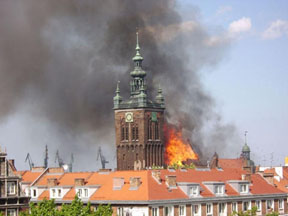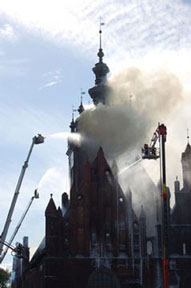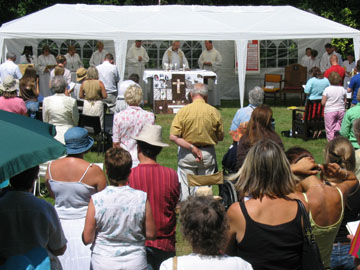|
no. 3 july - september 2006
The historic 12th century Carmelite church in Gdansk, Poland was partly destroyed by fire on the afternoon of May 22, 2006. According to Dariusz Borek, the Prior Provincial of the Polish Province, the roof was completely destroyed. While the ceiling, made of concrete, remained intact, the walls of the church suffered "grave" damage. Because of the fire resistent construction of the ceiling, any items of historical value were able to be carried out of the church during the fire. "We need to give a big thanks to the firemen for saving so many things," said Fr. Borek. The items have been distributed to various locations for safe keeping. Among the works of art were paintings by Izaak van den Blocke and Anton Moeller. "While we were able to save many items from damage, there is major water damage, especially to the walls of the building. The tower of the church also suffered some damage and the cupola has to be redone," said the Provincial. Estimates for the cost of repairs at this point run from 3-5 million euro. The church remains closed although the hope is to reopen soon the portion under the tower for the celebration of mass. The Carmelite residence, located next to the church, was not damaged during the blaze nor were any Carmelites injured. Carmelite Tadeusz Popiela has been named the new prior in Gdansk replacing Fr. Lukasz Semik who was present when the Carmelites first took over St. Catherine’s Church in the 1950’s. The Church of St. Catherine was founded in 1184 and until 1343 served as the only Catholic parish in the town. From 1555-1945 the church belonged to Protestants. In 1945 the Russians destroyed the church building. From 1953-1957 the church building was restored following the arrival of the Carmelites.
According to the Carmelite Provincial the carillon was saved but the instrument to play it has to be rebuilt. The church’s 37-bell carillon has chimed every hour on the hour since the 50th anniversary of the outbreak of the Second World War. The City of Gdansk maintains a clock museum in the bell tower of the church. Another significant historical feature of the church is the tomb of 17 th century Gdansk astronomer Johann Hevelius.Polish national television interviewed Adam Koterkiewicz, director of the historical museum of the City of Gdansk, who emphasized the importance of the works of art involved in the fire. Polish art historian Andrzej Januszajtis called the fire "the worst disaster to the monuments of Gdansk since the Second World War." The cause of the fire is yet to be determined. However, there was ongoing construction on the church’s roof although not at the time of the fire. According to some reports, 20 fire trucks were on scene hours after the fire started. The church was also heavily damaged from a fire in 1905. Flames consume the roof of the Carmelite church in Gdansk, Poland on May 22, 2006. Firemen with high altitude firefighting equipment manage to save the 14th century belltower, considered the most beautiful in the city. The fire has been called "the worst disaster to the monuments of Gdansk since World War II." Meetings of the Argovalentine Province Celebrate Restoration 100 Years Ago This year the Argovalentine Province is celebrating 100 years since its restoration. On April 18-20, the provincial assembly was held at El Carmen in Onda, Spain, under the direction of the psychologist Dr. Isabel Mairal on the theme "Abundance in the Mystery of Love: Passionate Hearts Finding Comfort in Carmel" On May 25, the feast of St. Mary Magdalen de’ Pazzi, the patron saint of the province, a solemn celebration was held at El Carmen in Onda. The theme was "Giving Thanks for the Lord and Our Lady of Mount Carmel for 100 Years of the Restoration of the Province." Many religious, Carmelite sisters and lay friends of Carmel attended. Various events took place to make for a very solemn and participative day. Finally the prolific Carmelite writer Fr. Rafael María López Melús has written a book to commemorate the restoration of the Province. The 600 page book, with an abundance of photos is divided into two parts (1275-1835; 1878-2006) and contains almost 2,000 notes. More information on the book will be contained in the next Res Carmelitana section published in CITOC.
On 16 th July 2006 the Carmelite friars and parish community celebrated 80 years of Carmelite presence in Faversham.In July 1926 a group of friars from Ireland, led by John Cogan, took over what was then a struggling mission. Thanks to the commitment in the early days of Malachy Lynch and then Elias Lynch, the parish has flourished and the Shrine of St. Jude now brings pilgrims from far and wide. The celebrations on 16 th July 2006 were blessed with warm sunshine and over 300 parishioners gathered to celebrate the commitment of the parish community over the years. The celebrations took place in the priory grounds, and after Mass everyone enjoyed a buffet lunch, barbeque, and music provided by groups around the parish. It was agreed that Elias Lynch who loved a party would have been with us in spirit.The Carmelite parish in Faversham, the Shrine of St. Jude, gathered for an outdoor Mass on July 16, 2006, to celebrate the 80th anniversary of the parish. (Photo courtesy of the parish) The crowds gathered in Il Carmine in Naples, Italy on July
15th to celebrate the Feast of Our Lady of Mount Carmel including the
Incendio of the basilica’s bell tower, a tradition thought to date
back to the middle 17th century. The incredible fireworks display engulfs
the bell tower only to be extinguished by a large image of Our Lady of
La Bruna.
|
|
RETURN TO THE INDEX FOR 2006 | RETURN TO THE INDEX FOR THIS ISSUE INDEX OF CARMELITE
WEBSITES |


 The distinctive 76 meter tall bell tower of St. Catherine’s was
completed in 1486 and is considered the most beautiful in the city. In
1989, on the 50th anniversary of the outbreak of World War II, a new
carillon consisting of 37 bells was blessed. The carillon was a
Polish-German venture, intended as an act of restitution and is the
largest carillon in Central Europe. Each bell bears a different
inscription each of which was written jointly by Poles and Germans. One
bell is a gift from the Jewish citizens of the city.
The distinctive 76 meter tall bell tower of St. Catherine’s was
completed in 1486 and is considered the most beautiful in the city. In
1989, on the 50th anniversary of the outbreak of World War II, a new
carillon consisting of 37 bells was blessed. The carillon was a
Polish-German venture, intended as an act of restitution and is the
largest carillon in Central Europe. Each bell bears a different
inscription each of which was written jointly by Poles and Germans. One
bell is a gift from the Jewish citizens of the city.